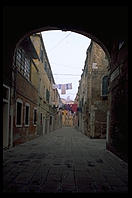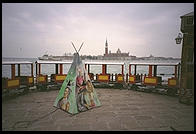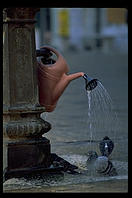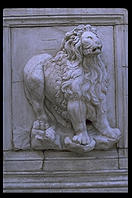
Venice: Castello
by Philip Greenspun; revised December 2007

The western part of Castello is scarcely distinguishable from San Marco. The eastern part holds public gardens and houses for locals that few tourists see, except during the Biennale (see "Art and the Biennale").
This is known as "the Vivaldi church" after local hero Antonio Vivaldi (1678-1741). If you want to understand why his music was so happy, take a look at the view from the quayside in front of La Pietà. If you don't think that was enough, reflect on the fact that Vivaldi had at his, er, disposal, an orchestra made up of 1000 orphaned teenage girls. How there got to be so many orphans in a relatively small city is partly explained by Thomas Coryat, an Englishman who toured Venice in 1608 and published his account of the city in Coryat's Crudities (1911):

As for the number of these Venetian courtesans it is very great. For it is thought there are of them in the whole city and other adjacent places, as Murano, Malamocco, etc. at the least twenty thousand, whereof many are esteemed so loose that they are said to open their quivers to every arrow, a most ungodly thing without doubt that there should be tolleration of such licentious wantons in so glorious, so potent, so renowned a city. ... First, they think that the chastity of their wives would be the sooner assaulted, and so consequently they should be capricornified, (which of all the indignities in the world the Venetian cannot patiently endure) were it not for these places of evacuation. But I marvel how that should be true though these courtesans were utterly rooted out of the city. For the gentlemen do even coop up their wives always within the walls of their houses for fear of these inconveniences, much as if there were no courtesans at all in the city. So that you shall very seldom see a Venetian gentleman's wife but either at the solemnization of a great marriage or at the Christening of a Jew, or late in the evening rowing in a gondola. The second cause is for that the revenues which they pay unto the Senate for their tolleration do maintain a dozen of their galleys...
So infinite are the allurements of these amorous Calypsoes, that the fame of them hath drawn many to Venice from some of the remotest parts of Christendom to contemplate their beauties and enjoy their pleasing dalliances. And indeed such is the variety of the delicious objects they minister to their lovers, that they want nothing tending to delight. For when you come into one of their palaces (as indeed some few of the principallest of them live in very magnificent and portly buildings for for the entertainment of a great prince) you seem to enter into the Paradise of Venus. For their fairest rooms are most glorious and glittering to behold. The walls round about being adorned with most sumptous tapistry and gilt leather. Besides you may see the picture of the noble courtesan most exquisitely drawn. As for herself, she comes to thee decked like the queen and goddess of love. ... And amongst other amiable ornaments she will show thee one thing only in her chamber tending to mortification, a matter strange amonst so many irritamenta malorum, even the picture of our Lady by her bed side, with Christ in her arms, placed within a cristal glass...
If any of [the courtesans] happen to have any children (as indeed they have but a few, for according to the old proverb the beset carpenters make the fewest chips) they are brought up either at their own charge or in a certain house of the city appointed for no other use but only for the bringing up of the courtesan's bastards, which I saw eastward above St. Mark's street near to the seaside. In the south wall of which building that looketh towards the sea, I observed a certain iron gate inserted into a hollow piece of the wall, betwixt which grate and a plain stone beneath it there is a convenient little space to put in an infant. Hither doth the mother or somebody for her bring the child shortly after it is born into the world; and if the body of it be no greater but that it may conveniently without any hurt to the infant be conveighed in at the aforesaid space, they put it in there without speaking at all to anybody who is in the house to take charge thereof. From thenceforth the mother is absolutely discharged of her child. but if the child be grown to that bigness that they cannot conveigh it through that space, it is carried back again to the mother, who taketh charge of it herself, and bringeth it up as well as she can. Those that are brought up in this aforesaid house, are removed therehence when they come to years of discretion, and many of the females if they be fair do imitate their mothers in their gainful faculty and get their living by prostituting their bodies to their favourites.
Excellent concerts are often given in "Vivaldi's church," certainly on Thursdays at 8:30 pm. Try to get there at 8 pm so you can snag one of the more comfortable plastic chairs. Spend the half hour looking up at the ceiling fresco by Tiepolo, Triumph of Faith (1755).

|
The church in the square contains Palma il Vecchio's polyptch St. Barbara and Saints (c. 1510; at right). But I found the pigeons in the impromptu fountain at left more interesting. |

|
A strange place that might be good with children, reasonably well signed in English and Italian, this museum has a lot of interesting models of old Venetian ships. In addition, there are varied exhibits from modern times, including a human-guided torpedo used by the Italian Navy in World War II (the pilots would jump off shortly before impact with British warships, a number of which were sunk with this weapon).
 If you started doing some
etymological research on "ghetto" in Cannaregio, a good place t o pick up is with
"arsenal" in Castello. "Arsenale" in Italian comes from the Arab darsina'a
("house of industry"). A walled-in complex of factories and forges, the Arsenale
was the world's largest shipyard in the 16th century, capable of building a
good-sized warship every day.
If you started doing some
etymological research on "ghetto" in Cannaregio, a good place t o pick up is with
"arsenal" in Castello. "Arsenale" in Italian comes from the Arab darsina'a
("house of industry"). A walled-in complex of factories and forges, the Arsenale
was the world's largest shipyard in the 16th century, capable of building a
good-sized warship every day.
Today it is used by the Italian military for obscure purposes and is closed to tourists except those on the 23 and 52 vaporetto lines, which cruise through the middle. There are some interesting lion statues in front, looted from various spots around the Venetian Empire.
A must-see for the Carpaccio painting of St. George slaying the dragon (1502-1508). Open mornings and some late afternoons.

|
La Donna Partigiana, a monument to the women killed fighting in WWII, on the Riva Dei Sette Martiri. At right is a fog-filled park not too far away. |

|